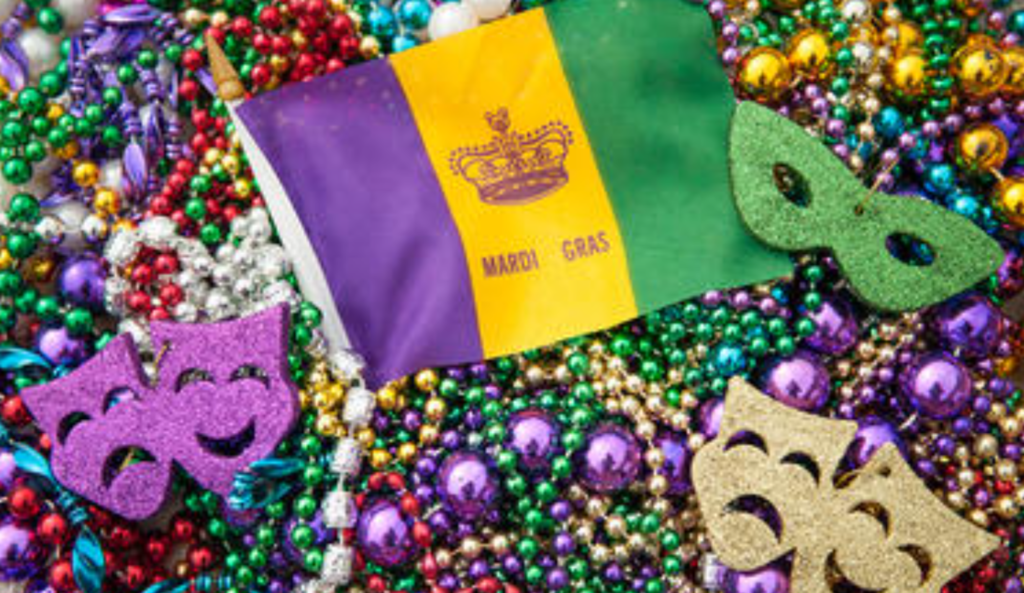CUA Hosts Multiple Celebrations for Mardi Gras

Image Courtesy of Explore Louisiana
By Anthony Curioso
How do you celebrate Mardi Gras? One day before Ash Wednesday officially ushers in the Lenten season, many people use the day to celebrate and eat copious amounts of food. This day is also colloquially called “Fat Tuesday” in some parts of the United States as it is the English translation of Mardi Gras.
This year, Mardi Gras fell on March 4. The CUA Center for Cultural Engagement (CCE) hosted a celebration in the Nest space within the Pryzbyla Center from 5:30 to 7 p.m. In the previous two years, Dining Services has hosted the CUA Mardi Gras celebration in Garvey Hall. Dining Services announced the day before Mardi Gras that they would host a Mardi Gras celebration again the following day. The Garvey Hall celebrations featured a DJ, Mardi Gras activities and props, and the chefs’ best attempt at making traditional Mardi Gras dishes. This year’s Mardi Gras festivities hosted by the CCE featured homemade gumbo, mask making, and a presentation for people to learn more about the history of the celebrations in New Orleans.
Emma Bonney, a freshman politics major and native of Louisiana, commented on her role in making the CCE’s Mardi Gras celebration happen.
“I wanted to have an event for Mardi Gras on campus, so I decided to email [CCE director] Javier Bustamante to ask what we could do,” Bonney said. “The CCE is providing all the supplies for the event, including the ingredients for me to make my family’s homemade gumbo.”
The CUA festivities were not the only Mardi Gras celebration in the DC area leading up to or on the day of Mardi Gras. The Washingtonian reported on several restaurants, bars, and bakeries that held events or promotional sales on the weekend leading up to the holiday, including The Wharf, Metrobar near Rhode Island Avenue, and several places in Virginia.
The most notable Mardi Gras celebrations take place in New Orleans, Louisiana. The city hosts numerous Mardi Gras parades each year, and the New Orleans tourism website indicates that festivities begin as early as January 6. During these parades, riders on the parade floats throw beads and other trinkets into the audience for people to catch. Many New Orleans residents traditionally wear masks for Mardi Gras parades and other festivities; Louisiana state law requires float riders to wear masks during the parades.
Traditional food for Mardi Gras celebrations includes king cake, a cake made in a wide variety of flavor options that contains a tiny figurine of a baby somewhere inside. A popular legend dictates that the person who finds the baby figurine will receive good luck and the responsibility of hosting next year’s Mardi Gras celebration and providing the next king cake. Other traditional Mardi Gras dishes include gumbo, a stew traditionally made from meat, vegetables, and Cajun spices; jambalaya, a dish containing elaborately spiced meats, seafood, vegetables, and rice; and beignets, a New Orleans variation of a donut that is typically topped with powdered sugar and served with some dipping sauce.
Bonney commented on her favorite Mardi Gras food.
“My grandmother passed down her gumbo recipe through the generations of our family,” Bonney said. “It contains chicken, onions, andouille sausage, and lots of spices, and it is delicious.”
Because of the cultural significance of Mardi Gras in New Orleans, the city has a website containing information on the history of local celebrations, information that attendees need to know about the scheduling and logistics of the annual events, and an outline of how to experience your preferred views and attractions throughout the city during the Mardi Gras season.
Bonney commented on her family’s Mardi Gras traditions.
“My family has made a lot of trips to Lafayette, Louisiana for Mardi Gras because my grandmother lives there,” Bonney said. “We love the parades, especially Tucks, because the parades have lots of interesting party favors and almost no one goes home empty-handed.”
Whether CUA students celebrated on or off campus, Mardi Gras offered one final opportunity to indulge before the penitential season of Lent, during which Catholics reflect on the sacrifice made by Jesus Christ on the Cross in preparation for celebrating His Resurrection at Easter. In 2025, Easter Sunday falls on April 20.






